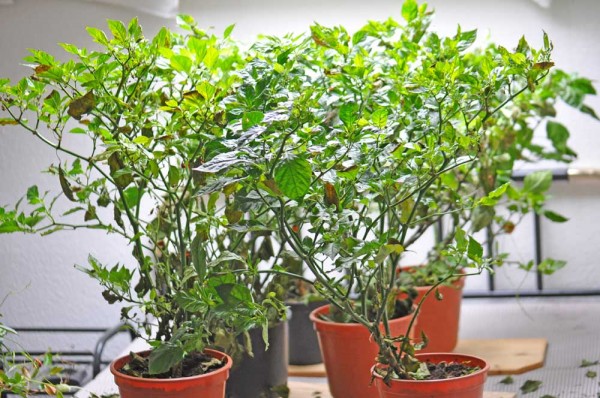Overwintering chillies

Overwintering chillies
Instructions for the overwintering of chili plants
According to literature, only one of the 5 chili types is perennial. This is the Capsicum frutescens, whose most well-known representatives are Tabasco and Cayenne chillies. We have to disagree with this botanical definition. In our experiments, all varieties of chili were able to be successfully overwintered. In our eyes, there is a clear policy on which chili types should not be overwintered. For all chili types that have a strong growth (Serrano, Jalapeno, Inferno etc.) or grow quickly in the respective climate, the effort is not worthwhile. The annual sowing in spring is clearly easier and more efficient.
How can I go about overwintering chili plants ?
After harvesting, leave the chili plants outdoors in a sheltered area for as long as possible. As soon as the temperature falls below 10 °C, the plants should be moved to another place. A bright and cool place with temperatures from 10-15 °C is suitable. We do not recommend overwintering when the temperature is under 10 °C, as the growth and the chili harvest in the following year will be significantly smaller. Temperatures of approx. 20 °C, on the other hand, are unproblematic. The following places are particularly suitable: A winter garden, a heated greenhouse, a bright living room with maximum temperatures of 20 °C, a bright hallway.
There are 5 key threats to overwintering chili plants
- Temperatures under 10 °C, or frost
- The place being too dark
- The plants becoming mouldy because the soil is too damp
- The plants drying out because the soil is too dry
- Pests (aphids, white flies)
The first 4 of these will definitely kill your chili plants. However, we should look at the last point, “Pests”, in more depth. If you place chili plants in a heated room, they will soon be covered in aphids and white flies.
There are 2 possibilities:
The first is for people who do not like to spray poison
Cut the chili plants back when necessary. Alternatively, you can cut off dry branches over the course of the winter. The plants will gradually lose their leaves, and the thin branches will dry out. The pests will automatically be gone when the leaves fall off. So if you don’t have a problem with a lot of dirt and a few pests, then you can avoid spraying poison. We have overwintered chillies using this method for several years, and each year we have a larger chili harvest than the previous year. Note: We did not cut back the plants before overwintering them. A radical cutting back may be accompanied by a reduction in the harvest. Tip: On a warmer winter’s day you can wash away a large proportion of the pests using a fine jet of water (e.g. from a garden hose). We have used this method on our lemon trees for years. This method is time-consuming and does not eliminate all pests, but you can use the lemon peel in baking and cooking with a good conscience.
The second method is for people who would prefer to spray poison
Nowadays there are some very good ecological and rapidly degradable pest poisons. Using anything else is irresponsible when dealing with food. Cut the chili plants back when necessary. Alternatively, you can cut off dry branches over the course of the winter. Spray the plants evenly according to the instructions on the packaging of the plant protection product. Your plants should now get through the winter without pests. Be sure to check regularly.
Watering the plants correctly
Before you bring the chili plants inside the house, the soil should be as dry as possible. If you place the chili plants in a 10 °C cold room, for example, it will take several weeks for the soil to dry. During this time period the plants can already go in. Even in rooms with a temperature of 20 °C, the drying process will take a very long time.
The soil should never be wet over the winter, instead it should be dry to slightly moist. Regularly monitor the chili plants at the beginning to get a idea of how often they need to be watered. You should not go overboard with ensuring that the soil is dry, as we have also had plants which have dried out. Instructions for watering are not useful, because at a high level of humidity and low room temperature, you may not need to water the plants at all.
The right start in the spring
The plants should not be fertilised over the winter. In the spring (temperatures should constantly be 10-15 °C), the chili plants should be placed in slightly bigger pots as in the previous year. New potting soil is also very important for healthy and strong growth. From this point on, you can regularly fertilise the soil until the harvest. We recommend using our Organic Chili Fertiliser.
Further info: Cutting back chili plants und buying early chili plants
We will soon present a report with images on the topic of “Overwintering Chili Plants”. The following varieties will be planted: Trinidad Scorpion Butch T, Habanero red, Habanero brown, Fatalii
Manufacturer
Name: | Chili-Food-Wissen |
Address: |
So viele Pflanzen entsorgt
Ich hatte so tolle Pflanzen, die reichlich und die besten Schoten hervorbrachten. Zum Ende der Saison landeten sie immer auf dem Komposthaufen. Nächstes Jahr werde ich die besten Pflanzen mal überwintern lassen.
Zimmer-Chilis außen vor
Es sollte zwar eigentlich klar sein, aber es sei noch von mir angemerkt, dass die Hinweise für in Zimmern stehende Pflanzen nicht gelten. Diese Dünge ich im Winter weniger, aber sie werden normal weiter gewässert und stehen am angestammten Platz. Stellenweise wachsen sogar vereinzelt Früchte, auch wenn die Reife sehr lange dauert.
Bezüglich Jalapeno: Ich habe Early und überwintere diese auch. Das hat bei mir im Folgejahr zu zwei sehr reichhaltigen Ernten geführt, im Anzuchtjahr gab es nur eine normale Ernte. Es kommt also darauf an ob es Zimmer- oder Gartenpflanzen und wie die Bedingungen sind.
In diesem Jahr gibt es dann erstmalig einen Feldversuch mit Frischluftpflanzen (allerdings im Topf) und der anschließenden Überwinterung.
Hilfreicher Bericht
Bisher habe ich noch keine Chilis überwintert, habe es mit anderen Pflanzen versucht. Dabei vermutlich etliche Fehler gemacht, wie ich dem Bericht entnehme. Auf ein Neues im nächsten Winter, diesmal mit Chilis.
Ich hatte keine Ahnung, dafür viel Fingerspitzengefühl.
Ich hatte wirklich keine Ahnung, hab mich nicht informiert, einfach nur gemacht.
Und meine geschenkte Chilli Pflanze
(Gartenträume 2018 HN) steht ohne Blattverlust ohne Läuse etc. Top da. Und trägt schon für ersten Blüten Ende März.
Ein kleiner Tip
Ihre Seite und ihre Infos sind Super.
Als ich vor 8 Monaten anfing eine eigene Chilli zu ziehen hatte ich wegen Wohnungshaltung die schwarze Spinne + Blattläuse.
Also lauwarmes Wasser ins Waschbecken, einen Tropfen Neemöl und Geschirrspülmittel hinein, kurz durchquirlen und dann den ganzen Pflanzenoberteil darin tauchen. Das ganze nach zwei Tagen wiederholt und die ganzen Tierchen waren weg.
BG
Bericht gefällt mir
Ihr Bericht ist gut. Aber nichts dazu geschrieben, wie die Pflanze im Winter aussieht. Meine ist übersäht mit Läusen und hat kaum noch Blätter. 4 Cillis hängen noch. Blüten kommen immer neue, aber fallen ab. Sie steht jetzt im Wohnzimmer.
 Chili pest control
Chili pest control  Beneficial Insects
Beneficial Insects 







